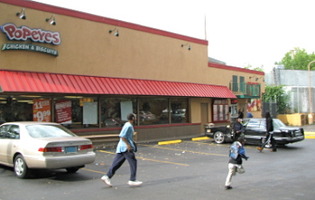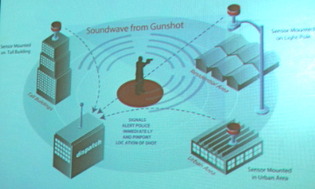 When a man got shot behind Popeye’s on Monday, no one called 911 — but a rooftop sensor sent cops an instant alert.
When a man got shot behind Popeye’s on Monday, no one called 911 — but a rooftop sensor sent cops an instant alert.
The alert came in at 7:14 p.m. though the city’s new Shot Spotter program, said Lt. Robert Muller. The system employs sensors to detect gunfire and locate where it came from.
A 24-year-old man was shot once in the stomach in the parking lot behind Popeye’s Restaurant at 31 Whalley Ave., police said. He remains in critical condition.
A man named Michael, who sells CD’s outside Popeye’s, said he heard one shot — “pop!” — and saw a Jeep flee the scene. He didn’t call 911. He thought people at Popeye’s would, he said.
Muller highlighted the incident during a press conference at police headquarters Tuesday to show how a new gunshot-detection program can save time — and possibly, a life.
Over the past year, the city has installed 22 sensors on rooftops in a 1.5‑mile radius in the Dixwell/Newhallville neighborhood. The sensors, paid for by a half-million dollar federal grant, listen for gunshots. Last Friday, the system went live. On Monday evening, cops said, it showed its worth.
The early advisory sent through Shot Spotter shaved five to seven minutes off of police’s response time, and helped them get to the shooting scene while there was still evidence there, Muller said.
When the shot went off, “we did not get a 911 call,” he said.
 However, the shot was picked up by three nearby microphones perched on rooftops at secret locations, Muller said. The sensors listen only for certain types of noise — they can distinguish between fireworks, a car’s backfire, and the sound of a gun going off. Police said they are not used to record conversations or any other noises.
However, the shot was picked up by three nearby microphones perched on rooftops at secret locations, Muller said. The sensors listen only for certain types of noise — they can distinguish between fireworks, a car’s backfire, and the sound of a gun going off. Police said they are not used to record conversations or any other noises.
The city has trained three people per shift to listen for Shot Spotter reports, which come to the city’s 911 dispatch center, on the fourth floor of the police department at 1 Union Ave. The program uses triangulation to pinpoint within four feet of where the gunshot took place. It puts that point onto a city map, and gives dispatchers the street address where the incident occurred.
Within “milliseconds” of the shot at Popeye’s, dispatchers at the 911 center heard an “obnoxious” wailing sound, Muller said. That meant one thing: The Shot Spotter had “hit” on a bullet. Dispatchers played back the tape to hear for themselves, and concluded it sounded like gunfire. They sent cops to Popeye’s.
They got to the scene in time to find “evidence” and a witness, police said.
Shot Spotter beat traditional police techniques by about five to seven minutes, Muller said. That’s how long after the shot was fired that a cop at Hospital of St. Raphael called into the dispatch center. He reported that a man had arrived with a gunshot wound to the abdomen.
In this case, the victim was cooperative in telling cops where he was when he was shot. But in a different scenario, where the victim is not cooperative, cops may never have known where the shooting took place, Muller said.
Police spokesman Officer Joe Avery offered another scenario: What if the man had been left to die in the parking lot in critical condition? In that case, Shot Spotter could have “saved his life.”





I know that the NHPD at all levels spent a lot of time working on this -- congratulations.
Perhaps cameras (like the 100+ set up in Newark by Cory Booker) are a good next step towards reducing crime & reclaiming our neighborhoods.